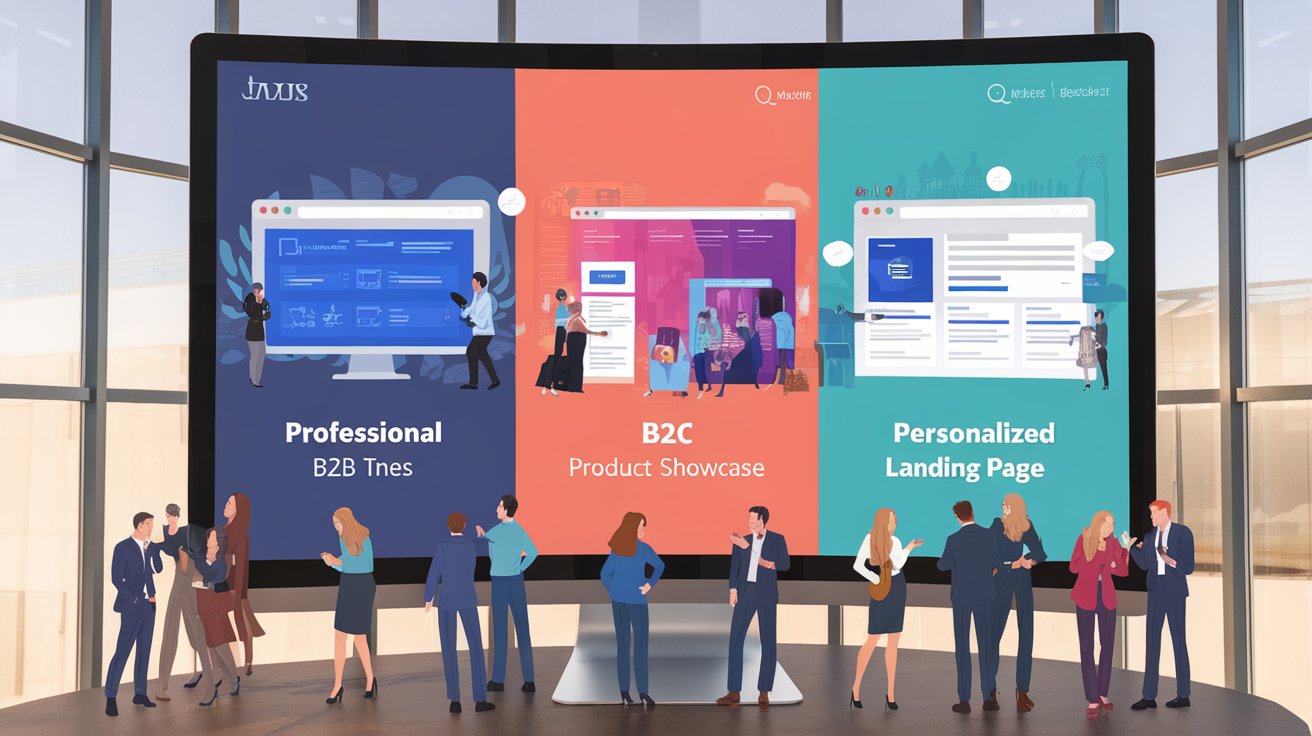Introduction
Creating one website that works for multiple audiences can be a real balancing act. You need to make sure the website appeals to every audience without losing its focus. The trick is to design a single website that hits the sweet spot for each target audience. This way, you don’t have to worry about managing multiple websites or missing out on connecting with anyone.
Now, think about how your target audience will use the site. A well-thought-out web design can help guide different people to the info they need, turning your site into a go-to place for everyone. Even though the audiences might be different, they should all feel like they belong on your one website.
Key Takeaways
- Understanding your varied user base is crucial when designing a website that speaks to multiple audiences.
- Segmenting your users into distinct groups helps create a personalized user experience.
- Balancing shared content with tailored experiences ensures your website meets the needs of all audiences.
- A well-structured homepage with clear navigation and personalized content areas serves multiple audiences effectively.
- Landing pages with targeted value propositions and integrated related content help captivate and convert diverse audience segments.
- Using related posts strategically enhances user engagement and improves SEO on your website.
Creating a Website That Speaks to Multiple Audiences
When designing a website that speaks to multiple audiences, the key is understanding your varied user base and addressing their distinct needs. A website for multiple audiences must strike the right balance between shared content and tailored experiences. This approach ensures that each segment feels valued and understood. By clearly defining your goals, you can develop a site structure that resonates with different audience types. Incorporating functionality like dropdown menus or segmented content areas can help users find the information they need quickly. Additionally, a cohesive design that unites these elements will create a user experience that captivates and engages every visitor, whether they are B2B clients, B2C customers, or stakeholders.
Key Strategies for Designing a Website for Multiple Audiences
1. Segment Your Audience for Targeted Content
Understanding and segmenting your audience is the first step in designing a website that works for multiple audiences. By categorizing users based on their needs and interests, you can tailor content and design elements that resonate with each group, ensuring a personalized experience that feels relevant to them.
2. Personalize Content to Engage Diverse Audiences
Once you’ve segmented your audience, it’s crucial to personalize the content for each segment. This could mean displaying different homepages, product offerings, or even blog posts depending on the user’s profile. Personalization helps in making each audience feel that the website was built just for them, increasing engagement and satisfaction.
3. Optimize Navigation and UX for Multiple User Groups
A well-designed navigation system is key to serving multiple audiences effectively. Use intuitive menus, segmented content areas, and smart UX design to help each user group find the information they need quickly. This reduces frustration and enhances the overall user experience, making the site more accessible to everyone.
4. Implement Tailored CTAs to Drive Conversions
Clear and targeted calls to action (CTAs) are essential in guiding different audience segments toward the actions you want them to take. Whether it’s signing up for a newsletter, making a purchase, or downloading a resource, customized CTAs can significantly improve conversion rates by speaking directly to the needs and motivations of each audience.
5. Maintain Consistent Branding with Flexibility
While it’s important to maintain a consistent brand image across your website, it’s equally important to allow flexibility in how content is presented to different audience segments. This balance ensures that your site remains cohesive while still catering to the specific preferences of each user group.
Understanding Your Audience Segments
To design a website that resonates with multiple audiences, it’s crucial to first understand who these audiences are. Start by segmenting your users into distinct groups based on their needs, interests, or behaviors. Whether you’re targeting B2B, B2C, or other specific groups, knowing your audience will guide your design decisions. This segmentation allows you to develop unique content and features that cater to each group’s preferences. By doing so, you’ll create a more personalized user experience, making each visitor feel like the site is speaking directly to them. This understanding is the foundation of a website that effectively serves multiple audiences.
Balancing Shared Content and Tailored Experiences
One of the challenges of creating a website for multiple audiences is finding the right balance between shared content and tailored experiences. Shared content creates a cohesive brand image, while tailored experiences ensure that each audience segment receives the information most relevant to them. Consider using elements like dropdown menus or segmented content areas that allow users to easily navigate to the sections that apply to them. By maintaining a balance, you’ll be able to serve diverse audiences effectively without overwhelming them with unnecessary information. This approach helps keep your website organized and user-friendly, ensuring that it meets the needs of all visitors.
Designing an Effective Homepage to Serve Multiple Audiences
The homepage is often the first impression your website makes, so it must serve multiple audiences effectively. To achieve this, focus on creating a clean and intuitive layout that directs users to the appropriate sections of the site. Incorporating elements such as clearly labeled navigation bars, visual cues, and personalized content areas can make it easy for users to navigate the site and find the information relevant to them. By using best practices in UX design, the homepage can guide users through various sales funnels, helping them to reach the content or products that resonate with them. This approach ensures that your site’s homepage doesn’t just attract visitors, but also engages and retains them.
Case Study: BBC’s Homepage Redesign for a Diverse Global Audience
The BBC faced the challenge of redesigning its homepage to serve a vast and diverse global audience. To achieve this, they focused on creating an intuitive layout that catered to different user segments, such as news readers, TV viewers, and radio listeners. The homepage was designed with clear navigation, allowing users to easily find content relevant to their interests. Additionally, personalized content areas were implemented, displaying news and programs tailored to the user’s location and preferences. This redesign not only improved user engagement but also ensured that the BBC’s varied audience felt connected and valued, making the site a go-to hub for millions.
Clear Navigation for Diverse Users
The homepage is the gateway to your website, so clear navigation is essential, especially when catering to multiple audiences. Implementing intuitive navigation bars, dropdown menus, and prominently placed links ensures that users can easily find the content relevant to them. Each audience should feel that their specific needs are addressed as soon as they arrive. By organizing your homepage in a way that directs users to the right sections, you reduce the chances of confusion and frustration, leading to a more satisfying user experience. This clear navigation not only improves usability but also helps retain visitors, guiding them through your sales funnels.
Personalized Content Areas
To serve multiple audiences effectively, your homepage should include personalized content areas that address the specific interests of different user groups. For example, you might have sections dedicated to B2B services, B2C products, or stakeholder information, each with tailored content. This approach allows you to speak directly to the needs of each segment, making them feel valued and understood. By using targeted messaging and relevant visuals, you can create a more engaging experience for all visitors. Personalized content areas on your homepage help in capturing the attention of diverse audiences, increasing the likelihood of conversions and deeper engagement.
Building Landing Pages That Cater to Diverse Audiences
Landing pages are essential in directing traffic to specific areas of your website, particularly when dealing with multiple audiences. Each landing page should be tailored to address the unique needs and interests of different audience segments. By developing unique value propositions and targeted messaging, these pages can effectively captivate and convert users. It’s crucial to know your goals for each landing page, as this will guide the design and content choices, ensuring that they align with the expectations of each audience type. Additionally, integrating related posts and product offerings can enhance user experience, making it easier for visitors to find more relevant content, thereby improving site navigation and engagement.
Crafting Targeted Value Propositions
When building landing pages for multiple audiences, it’s essential to craft targeted value propositions that speak directly to each segment. A well-defined value proposition highlights the benefits that your products or services offer to a specific group. This clarity helps in capturing the attention of visitors and guiding them through the conversion process. Whether you’re addressing business clients, individual consumers, or other stakeholders, your value proposition should be concise, clear, and compelling. By tailoring your messaging to the unique needs of each audience, you can create landing pages that are more effective in driving traffic and conversions.
Integrating Related Content and Offers
To maximize the effectiveness of your landing pages, consider integrating related content and offers that align with the interests of your audience segments. This strategy not only enhances the user experience but also encourages visitors to explore more of your website. For instance, you can link to related posts, product information, or special offers that cater specifically to the needs of different user groups. By providing relevant and valuable content, you keep users engaged longer, which can lead to higher conversion rates. This approach also supports your overall marketing strategy by creating more opportunities for cross-selling and upselling.
“Don’t find customers for your products, find products for your customers.”
Source: Seth Godin, This is Marketing
How to Use Related Posts to Engage Multiple Audience Types
Using related posts strategically can significantly enhance user engagement, especially when targeting multiple audience types. By linking to content that complements the user’s interests or needs, you create a more immersive experience on your website. This approach not only encourages visitors to explore more of your site but also helps to segment the audience naturally based on their interaction patterns. When related posts are well-integrated into your site’s design, they can serve as a seamless extension of the user’s journey, guiding them through relevant information and products. This method also supports SEO efforts by keeping users on your site longer, thereby increasing the likelihood of conversions.
Creating a Seamless Content Journey
Related posts can be a powerful tool for engaging multiple audience types, as they help create a seamless content journey on your website. By strategically placing links to related articles, products, or services, you guide users through a logical progression of content that deepens their engagement. This method not only keeps visitors on your site longer but also allows them to discover more relevant information that they might not have found otherwise. A seamless content journey is particularly important when dealing with diverse audiences, as it ensures that each segment feels supported and valued throughout their experience.
Enhancing SEO and User Retention
Using related posts effectively can also enhance your website’s SEO and improve user retention. By keeping users engaged with relevant content, you increase the time they spend on your site, which signals to search engines that your site offers valuable information. Additionally, well-placed related posts can reduce bounce rates by providing users with additional content to explore, preventing them from leaving your site prematurely. This approach not only improves your site’s search engine rankings but also helps build a loyal audience that returns to your site for more information, products, or services.
[lasso rel=”amazon-67″ id=”10432″]
Conclusion
Designing one website to serve multiple audiences can be a rewarding yet challenging task. The goal is to ensure that each specific audience feels understood and valued without the need to create separate websites. By focusing on website design that is adaptable and by understanding the persona of each user group, you can build a site that resonates across different segments. This approach not only simplifies management but also enhances the user experience, making it easier for everyone to find what they need with just the click of a button.
Ultimately, a well-thought-out website design can effectively appeal to multiple audiences while maintaining a cohesive and unified online presence. Whether you’re targeting a small business or a broader audience, the key lies in creating a site that feels like it was built just for them. With careful planning, your one website can become a versatile hub for diverse users.













